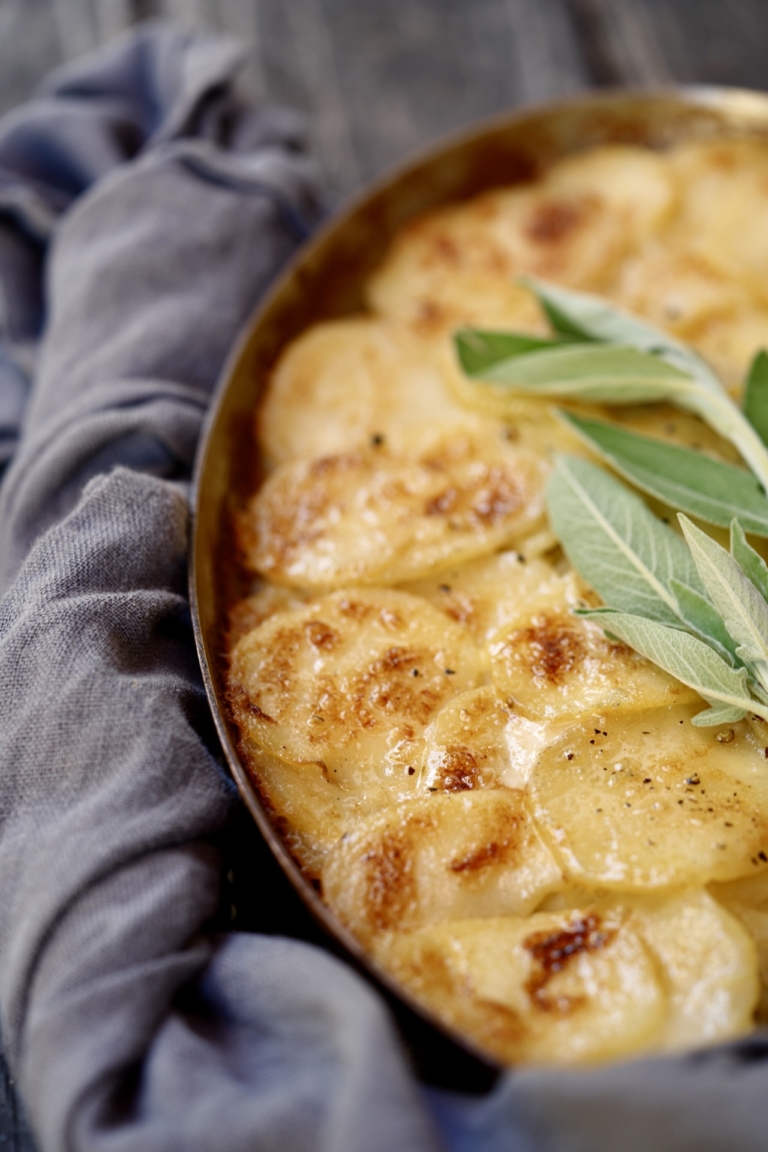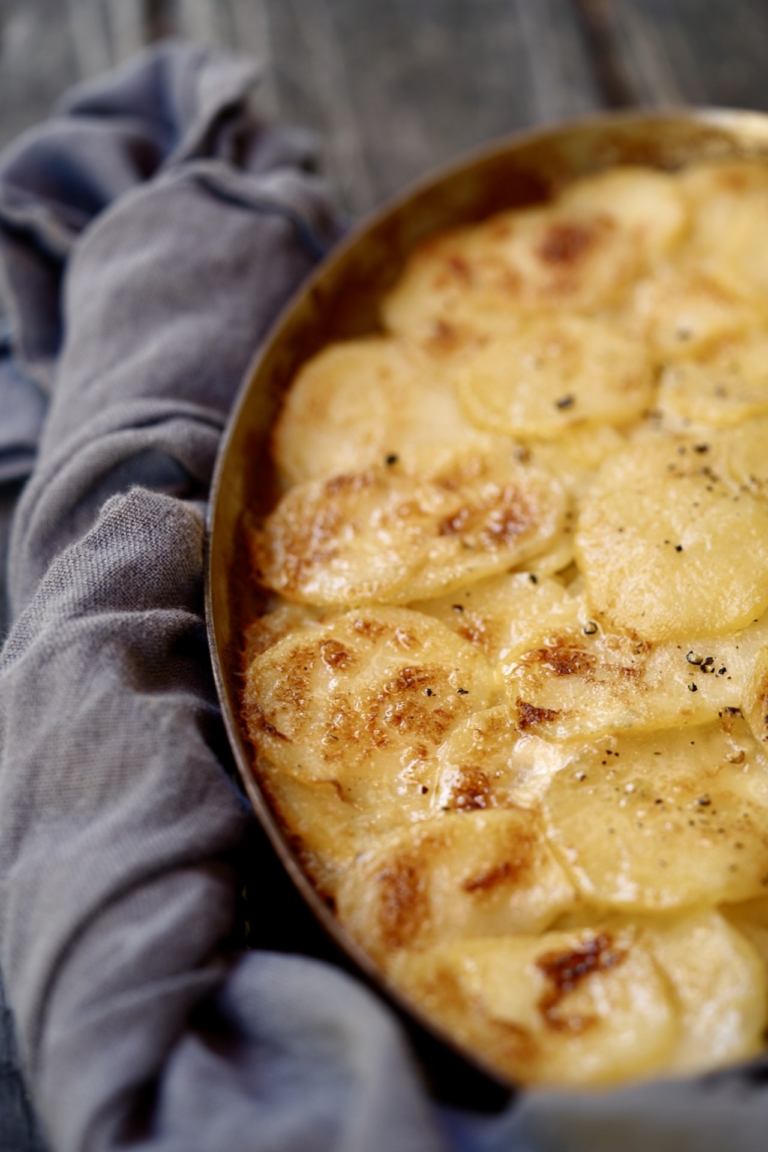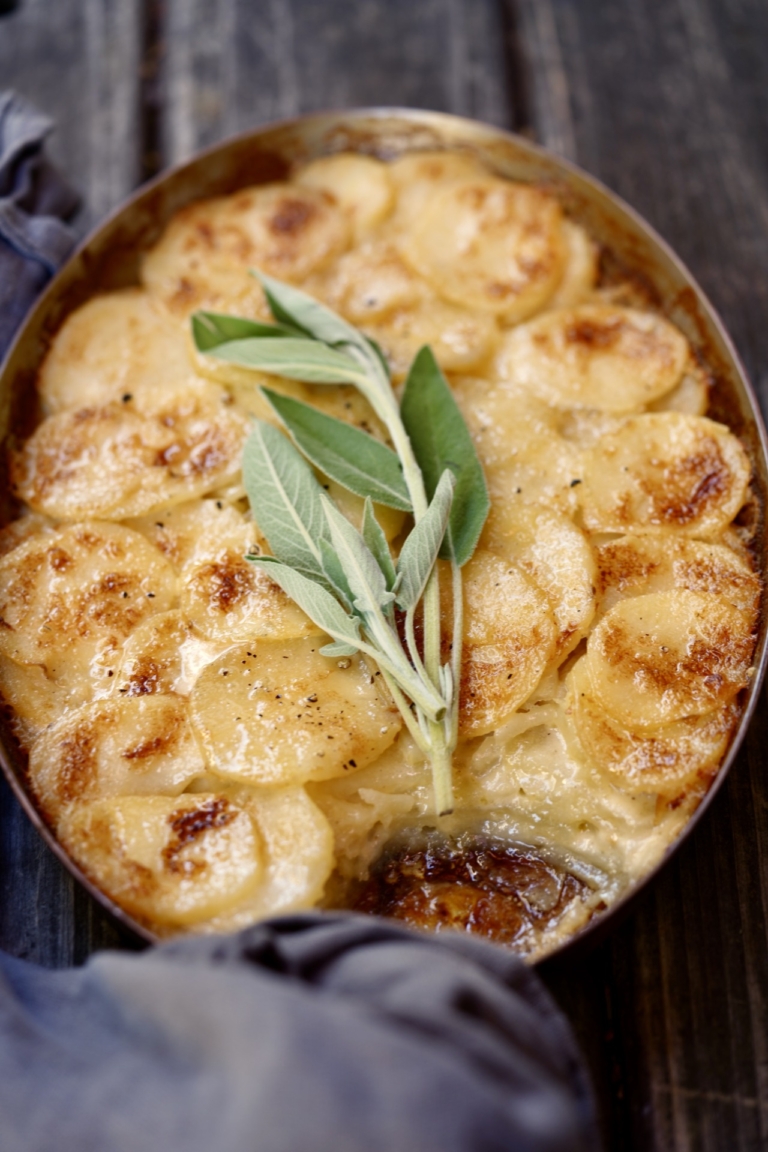Dauphinoise Potatoes

I was born in the mid-west and my love of potatoes and cheese confirms that. Dauphinoise potatoes (also known as Pommes de terre dauphinoise, potatoes à la dauphinoise, gratin Dauphinoise, and gratin de pommes à la dauphinoise) is a French dish of sliced potatoes baked in milk, or cream, (or a combination), using the gratin technique. In a nutshell, they are an easy elegant way to dress up potatoes. So if you’re looking for the perfect, prep-ahead potato dish for Thanksgiving, that everyone is guaranteed to love, look no further, this is it.
Dauphinoise potatoes are a classic French dish from the Dauphiné region in south-eastern France. Although similar to the American potato au gratin, they are creamier and more indulgent, due to the potatoes soaking in a rich cream/milk mixture they are cooked in. In this iconic French favorite, the starch in the potatoes themselves is what binds the whole dish together effortlessly.

Traditional Dauphinoise recipes don’t include garlic, but my recipe does, adding even more depth and richness to the overall flavor. The more common use of garlic in more standard Dauphinoise recipes would be to rub a raw garlic clove on the inside of the baking dish to capture its essence. Instead, I prefer to add the garlic to the cream mixture which still allows for a subtle garlic flavor that is not overwhelming to the potatoes themselves. While potato au gratin and Dauphinoise potatoes are similar style dishes there are some subtle differences between the two in terms of both ingredients and preparation.
Potato Au Gratin vs. Dauphinoise Potatoes
Cheese:
- Potato au Gratin: This dish typically includes cheese as a key component. The potatoes are layered with a mixture of cream, milk, and cheese, and the top is often baked to form a golden-brown, cheesy crust.
- Dauphinoise Potatoes: Traditionally, Dauphinoise potatoes do not contain cheese. The dish is made by layering thinly sliced potatoes with cream and milk, and sometimes garlic and nutmeg, creating a creamy texture without the addition of cheese.
Region of Origin:
- Potato au Gratin: While the origins of the dish are not strictly French, it is commonly associated with French cuisine. The term “au gratin” refers to the cooking method of browning the top layer.
- Dauphinoise Potatoes: This dish is specifically associated with the Dauphiné region in southeastern France. The name “Dauphinoise” reflects its regional origin.
Cheese Varieties:
- Potato au Gratin: The choice of cheese can vary, but common options include Gruyère, cheddar, or Parmesan.
- Dauphinoise Potatoes: This dish traditionally does not include cheese, focusing on the creamy texture created by the combination of potatoes and cream.
While these differences exist, it’s worth noting that the terms are sometimes used interchangeably, and variations in recipes can be found. Some modern recipes may incorporate cheese into Dauphinoise potatoes, blurring the lines between the two dishes. Ultimately, both dishes showcase the delicious combination of thinly sliced potatoes, cream, and flavorful seasonings, making them popular choices for comfort food, holiday or otherwise.

The real trick to making Dauphinoise potatoes is the sling itself. Potatoes are peeled and sliced to the thickness of a coin, usually with a mandoline; they are layered in a shallow baking dish, or this case, a pan which is what I prefer. Although I would encourage all home chefs to invest in a good mandolin, it is not required to make this dish. A good, sharp chef’s knife can work just as well. Although working with potatoes is a week-long class in culinary school, this recipe is forgiving, just make sure the potatoes are cooked through which is a rookie mistake made by many.
Dauphinoise Potatoes
Ingredients:
- 2 cups heavy cream
- 1 cup half-and-half
- 6 garlic cloves, peeled and smashed
- 1 sprig fresh sage
- 3 pounds Idaho potatoes, peeled and thinly sliced
- Salt and pepper to taste
Directions:
- Heat the oven to 350 degrees F. Butter 12x8 ovenproof dish, place on a baking sheet, and set aside.
- In a large saucepan add the the cream, half-and-half, garlic, and sage. Season with salt and pepper and place over medium heat. Reduce the heat and simmer for 10 minutes. Using a slotted spoon, remove the garlic cloves and sage and discard.
- Place the sliced potatoes and add to the saucepan. Gently stir and return the mixture to the boil. The potatoes and cream tend to stick to the bottom of the pan so keep an eye on them. Cook for about 4 minutes.
- Gently layer the sliced potatoes in the prepared baking pan and pour the cream mixture over them. Layer the slices of potato in the greased dish and pour the cream over them. Sprinkle each layer with a little salt and freshly ground black pepper. Cover the baking pan with aluminum foil and cook for 45 minutes. Remove the foil increase the oven temperature to 400 degrees and cook for an additional 15 minutes or until the top is golden and bubbling and the potatoes are tender.



Leave a Reply